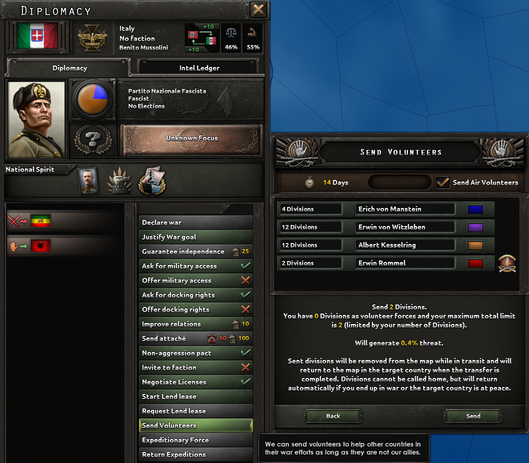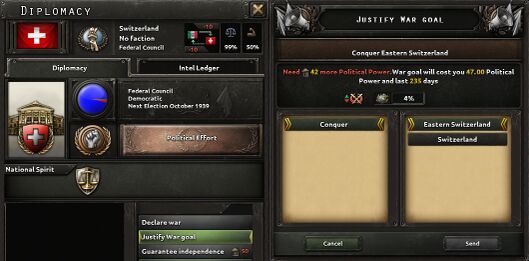(→远征军) |
(→志愿军) |
||
| 第46行: | 第46行: | ||
[[File:Send volunteers menu.png|529px|thumb|''派遣志愿军''界面]] | [[File:Send volunteers menu.png|529px|thumb|''派遣志愿军''界面]] | ||
派遣陆军师或空军联队作为志愿军,是一个国家派遣军队介入其他国家的战争而又不参加该战争本身的一种方式。在重大战争爆发之前的几年中,这是获得[[Experience|经验]]的好方法,而且对于一个国家而言无需外交干预就可以影响战争的结果。玩家还可以使用志愿军在战斗条件下对部队编制进行现场测试。志愿军的提供和加强由派遣国而不是接受国控制,并且派遣志愿军也可以增加 | 派遣陆军师或空军联队作为志愿军,是一个国家派遣军队介入其他国家的战争而又不参加该战争本身的一种方式。在重大战争爆发之前的几年中,这是获得[[Experience|经验]]的好方法,而且对于一个国家而言无需外交干预就可以影响战争的结果。玩家还可以使用志愿军在战斗条件下对部队编制进行现场测试。志愿军的提供和加强由派遣国而不是接受国控制,并且派遣志愿军也可以增加[[World Tension|全球 紧张度]] 。 | ||
一个国家在和平状态下只能向国外派遣志愿军。派遣志愿军的能力受到[[Ideology|意识形态]]和[[World Tension| | 一个国家在和平状态下只能向国外派遣志愿军。派遣志愿军的能力受到[[Ideology|意识形态]]和[[World Tension| 全球 紧张度]]的限制。只有[[Fascist|法西斯主义者]]可以随时随地这样做,而在其他国家,尤其是在民主国家,这一举动则相当受限。不过[[France|法国]]有能力较早地派遣志愿军。 | ||
为了派遣志愿师,首先必须组建一支集团军。这支集团军可以被分配一个[[commander|陆军上将]],他也可以赢得经验和特质。然后,通过“派遣志愿军”的外交行动将它们派遣出去。军队到达后,将为玩家创建一个新的军队战场,并自动向其中添加志愿军。即使其他国家有相同来源的志愿军,也不能将军队转移到这些特别战场或从这些特别战场转移。志愿军需要两个星期才能到达接收国或返回派遣国。如果他们的派遣国陷入战争,或者接受国的国家获得和平,他们将返回派遣国。志愿军返回时会携带95%的设备。其余的会遗失在运输途中或留在接受国家。玩家还可以解散志愿师,这将会把人力和设备退还给派遣国,但需要成立一个新的师并对其进行训练,以取代被解散的师。 | 为了派遣志愿师,首先必须组建一支集团军。这支集团军可以被分配一个[[commander|陆军上将]],他也可以赢得经验和特质。然后,通过“派遣志愿军”的外交行动将它们派遣出去。军队到达后,将为玩家创建一个新的军队战场,并自动向其中添加志愿军。即使其他国家有相同来源的志愿军,也不能将军队转移到这些特别战场或从这些特别战场转移。志愿军需要两个星期才能到达接收国或返回派遣国。如果他们的派遣国陷入战争,或者接受国的国家获得和平,他们将返回派遣国。志愿军返回时会携带95%的设备。其余的会遗失在运输途中或留在接受国家。玩家还可以解散志愿师,这将会把人力和设备退还给派遣国,但需要成立一个新的师并对其进行训练,以取代被解散的师。 | ||
2020年8月15日 (六) 21:58的版本
陆上作战
- 主条目:陆上作战
陆上作战即在陆地上进行作战。陆上作战由若干战斗队所组成的单位——“师”进行,若干个师可以组成一支由陆军上将领导的集团军。每个陆军上将可以指挥24个师,5个集团军可以构成一个由陆军元帅指挥的集团军群。可以使用游戏界面右下角的按钮或键盘快捷键F1查看相应的地图模式。
空中作战
- 主条目:空中作战
空中作战即在空中进行作战。空中作战由各式不同类型的飞机进行,这些不同类型的飞机可以在一定的作战半径内与敌人争夺制空权,轰炸敌人的工厂与基础设施,并为陆战部队提供近距离支援,以及袭击停靠在港口或行驶在海域中的敌方舰艇。空军部队不是由陆军上将领导,而是在战斗中随机培养王牌飞行员,为空军联队提供战斗加成。
海上作战
- 主条目:海上作战
海上作战即在海域中进行作战。海上作战由各式舰艇组成的舰队进行,这些舰队将在特定的作战海域与敌方海军争夺制海权,袭击敌方运输船队并为己方运输提供护航。海军舰队由海军上将进行指挥,海军上将依据其等级和特质为舰队提供加成。
Capitulation and defeat
| File:Ambox outdated info.png | 这部分内容可能已不适合当前版本,最后更新于1.9。 |
Capitulation occurs when a country at war loses control of more victory points of its owned core territory than its surrender limit. The limit is 80% by default but war support below 50% will decrease it by up to -30% and some national ideas can affect it too, most notably France's Disjointed Government national spirit (-50%). The surrender limit can usually not go below 10%, the only exception being Japan when losing Okinawa and Iwo Jima, having less than 40 ships, and getting hit by two nuclear bombs.
When a country crosses the surrender limit, it capitulates to the country that dealt the highest war score (see below) against them. If an enemy holds the capital, they get a 50% bonus and an extra 150 war score for the purpose of this selection. The capitulating country loses control of all owned provinces contiguous with its capital and all its troops there. If any allied troops were present, they will have to escape through the now enemy-controlled land.
Capitulation does not necessarily mean instant defeat for a country. If the country is fighting alongside major allies, the war will not be over until they are defeated. Countries will not surrender less than seven days after the war started even when capitulated, to give them time to join a faction for this purpose. Conversely, minor nations may be forced to surrender after all their major allies capitulate even though they themselves did not fall. This can be prevented by leaving the faction before all majors capitulate.
战争贡献
战争贡献是衡量一个国家对战争努力的贡献度。这是与同方所有国家相比所获得的相对战争分数的比例。分别计算对每个敌国的得分,但仅显示合计值。战争分数可以通过以下几种方式获得:
- 占领:
- 夺取敌人控制的省份:0.2×(1+0.2×<胜利点>)。例如一个正常省份的价值为0.2,而柏林(50胜利点)的价值为2.2。如果一个省多次被占领和夺回,则每次都会获得战争分数。
- 战斗:进行至少持续48小时的战斗,其价值为3×(1+0.2×<胜利点>)。防守成功方获得总战争分数的30%,进攻失败者仅获得20%。例如,如果苏联进攻柏林并输掉了战斗,它将获得3×(1+0.2×50)×20%=6.6战争得分,而德国获得3×(1+0.2×50)×30%=9.9。而一个未能成功守卫普通省份的国家只能获得3×1×30%×20%=0.18的战争得分。该分数是独立的,是对上述实际控制省份的战争分数的补充。如果是有多个国家参加战斗的任何一方,则该方的得分将根据每个国家所造成的实际损害按比例分配。
- 轰炸:战略轰炸任务或使用核弹对敌方建筑物造成的每点伤害都价值0.05战争得分(或每摧毁1幢建筑物获得5战争得分)。该分数的上限是1000分,每个月递减10分。
- 击沉敌方船只:击沉船只每1000人力获得0.2战争分数,船只每1000生产成本获得0.4战争分数。
- 伤亡:在与敌国作战时失去自己的人力则可以从每1000伤亡中获得0.1战争分数。如果国家放弃抵抗,则所获得的分数减半。
以上每个项目都会累积得分,然后将其与整个同盟的总体得分进行比较,以得出一定比例的战争贡献。该分数将在议和期间得到使用。战争贡献度也会影响盟友同意在战时移交占领地区的请求的可能性。
和平会议
- 主条目:和平会议
当战争结束并且所有敌国都被击败后,将会启动战后和平会议。
志愿军与远征军
志愿军和远征军是将士兵派往战场参战但是国家不必整体参加战争的操作,同时也是一种通过向盟国派兵从而协助他们的方式。
志愿军
派遣陆军师或空军联队作为志愿军,是一个国家派遣军队介入其他国家的战争而又不参加该战争本身的一种方式。在重大战争爆发之前的几年中,这是获得经验的好方法,而且对于一个国家而言无需外交干预就可以影响战争的结果。玩家还可以使用志愿军在战斗条件下对部队编制进行现场测试。志愿军的提供和加强由派遣国而不是接受国控制,并且派遣志愿军也可以增加全球紧张度。 一个国家在和平状态下只能向国外派遣志愿军。派遣志愿军的能力受到意识形态和全球紧张度的限制。只有法西斯主义者可以随时随地这样做,而在其他国家,尤其是在民主国家,这一举动则相当受限。不过法国有能力较早地派遣志愿军。
为了派遣志愿师,首先必须组建一支集团军。这支集团军可以被分配一个陆军上将,他也可以赢得经验和特质。然后,通过“派遣志愿军”的外交行动将它们派遣出去。军队到达后,将为玩家创建一个新的军队战场,并自动向其中添加志愿军。即使其他国家有相同来源的志愿军,也不能将军队转移到这些特别战场或从这些特别战场转移。志愿军需要两个星期才能到达接收国或返回派遣国。如果他们的派遣国陷入战争,或者接受国的国家获得和平,他们将返回派遣国。志愿军返回时会携带95%的设备。其余的会遗失在运输途中或留在接受国家。玩家还可以解散志愿师,这将会把人力和设备退还给派遣国,但需要成立一个新的师并对其进行训练,以取代被解散的师。
志愿军可以部署的师的数量是每20个师中有1个师可以派遣(因此有19个或更少的陆军师则无法派遣志愿军)。例如,176个现役师就可以派遣8个志愿师,而181个师则意味着9个师可以被部署为志愿军。请注意,只有1个营的师和拥有25个营的师是等价的。至少有20个1个步兵营的的师也可以派出1个志愿师。派遣国必须自始至终至少有30个师来维持派遣志愿军。此外,接受家或地区中每20个省可以划分为一个战区。 志愿者的空军联队也受到类似的限制。但是,它们是通过空军界面直接部署到目的地国家/地区的空军基地的,然后玩家可以正常设置他们的任务。
远征军
派遣远征军是战时将部队移交给盟友的一种方式。如果玩家不想控制他们,或者想要AI在战场上指挥战斗并且认为接受国会指挥得更好,这将非常有用。远征军可以随时移交并退回。解散远征军就可以直接退还远征军。如果有运输船队的话,AI也会经常通过运输船队运送远征军。
远征军从其本国而不是接受国那里获得设备和人力。不过接受国可以完全控制它们,直到远征军返回。由远征军占领的战争得分归于控制它们的国家,而造成人员伤亡的战争分数归其母国(提供远征军的国家)。但是,他们的装备供应是由控制国提供的,这意味着如果他们的供应情况比您的好,您可以使用远征队减轻供给压力。(理论上,如果德国失去了全部的运输船,但意大利没有,那么德国可以让意大利控制非洲军团以使用其正常供应的武器装备)
远征军的师可以获取经验,但接受国不得修改其模板。接收远征军的玩家可能希望向本国提供武器租借,以用于其向远征军提供装备。
![]() 您可以通过使用下方的空白头像按钮在屏幕底部创建新的集团军来为远征军创建一支空的集团军来请求远征军。您需要为该集团军创建命令(例如划好前线),以便AI能够接受您的请求。
您可以通过使用下方的空白头像按钮在屏幕底部创建新的集团军来为远征军创建一支空的集团军来请求远征军。您需要为该集团军创建命令(例如划好前线),以便AI能够接受您的请求。
由国家A提供给国家B的远征师保留国家A的陆军加成,而国家A的加成则由国家A的军事人员提供。军事人员包括高级指挥官和陆军参谋长。B国的军事人员加成不适用于借给B国的A国远征军。
其他一些尚待调查和测试的未知话题是,如何分配远征军在战斗或军事演习中产生的军队经验,以及如何确定因为本国更改模板所带来的人力和装备影响。
War goal
| File:Ambox outdated info.png | 这部分内容可能已不适合当前版本,最后更新于1.8。 |
A war goal is needed to declare war. A war goal is usually a conquest of a desired state.
Justifying a war goal costs political power, increases world tension and usually takes between 6-9 months to complete. When a country has a war goal, it can start a war against the target country. Countries succeeding in their war goals get an advantage in peace conferences. There are several national focus that will give countries historical war goals. However, ahistorical war goals are also possible, such as Sweden restoring its historical borders. The target state of the wargoal can be claimed at a discount at the peace conference. It is also possible to declare a Border war.
Factions Strength resume
At the end of game, beside individual scores, is the Factions ranking. This is derived from various statistics such as manpower, naval, air and ground forces, industrial power, terrain points, research, war progress, casualties, etc. Basically, it describes which faction has won the game.
Conditions
Besides the national focus, war goal justification will require one or multiple conditions to be met before it can even begin. The conditions will be different depending on the ideology (Communism, Democracy, Fascism or Non-aligned) as well as the faction (Allies, Axis, Commintern, others) and the ![]() World Tension level.
World Tension level.
Communism
Communists have virtually no restriction on justifying war goals.
Democracy
Democracies are very limited in how they can begin wars, to simulate the influence of popular opinion during the time period. These limitations are lifted if a country becomes fascist or communist.
- Cannot start a war against another democracy.
- Cannot justify against a nation that has not increased the world tension.
Fascism
Fascists have virtually no restriction on justifying war goals. If a fascist country is already at war with a major power, they can justify a new wargoal 80% faster than normal.
Ideological effect
All ideologies have one or multiple effect on the cost of war goal justification or enactment at the peace conference.
Communism
 Can force government.
Can force government.- 30% cost reduction when puppeting other countries.
Democracy
 Cannot send volunteers.
Cannot send volunteers. Cannot puppet another country.
Cannot puppet another country. Cannot occupy a country without war (captured neutral territory will be returned).
Cannot occupy a country without war (captured neutral territory will be returned).- 25% cost increase of Taking States.
- 50% cost increase of Annexing country.
Fascism
Neutrality
Political power cost
It's necessary to spend a certain amount of political power to start justification of a war goal.
The base cost is xx, then the following modifications can apply:
- -90% When justifying war goal against a major power at war.
Once the justification is ongoing, It will also be necessary to spend 0.2 political power per day on the war goal justification to complete it in the minimum number of days. Any deficiency in political power will stall the war goal justification.
Territorial control
| File:Ambox outdated info.png | 这部分内容可能已不适合当前版本,最后更新于1.8。 |
Province control
Control of a province changes when the first division of a country at war with the current controller enters the province while no defenders are present. This usually happens after the attackers won a battle or because the province was undefended to begin with. Divisions may enter from a neighboring land province, via paradrop, or naval invasion. Control of the state (Factories and resources) is tied to the "capital" province, usually the highest VP province within the state. There exists a capital province for states with no victory points, but which is impossible to know without prior knowledge. Control can potentially pass to any eligible country subject to the following rules. A country is eligible if it is at war with the original province controller and has given military access to the division's country, either explicitly or by being in the same faction.
The claim of an eligible country can be categorized with descending strength:
- owns the state the province is in
- has a core claim on the state
- has a generic claim on the state
The country with the strongest claim gains control. Ties between multiple countries with the same kind of claim are broken as follows:
- if the division's country is among them and it controls more neighboring provinces than any other tied country, it gains control
- otherwise the candidate with the largest civilian industry gains control
If no eligible country has a claim:
- the eligible country controlling the most neighboring provinces gains control (ties are broken by civilian industrial size)
- otherwise the division's country gains control
In all cases except the neighborhood rule, control passes to the master if the selected country is a subject.
State control
When an owner loses control of a state completely (i.e. when losing the last province) and the new controller controls an adjacent state as well, they gain full control of the state. Otherwise the surrounding states' controllers are checked for co-belligerent faction members of the new controller. If any are found, the state gets handed over to the one with the largest industry, with a slight bonus towards the faction leader.
Members of the same faction can explicitly pass control of states among each other with the diplomatic actions "Give control of state" and "Ask for control of state". AI allies will generally only agree to this if they consider their own share of controlled states large enough and the share of the other country not too large.
| 政治 | 意识形态 • 阵营 • 国策 • 内阁 • 政府 • 傀儡国 • 外交 • 全球紧张度 • 内战 • 占领区 • 情报机构 • 权力平衡 |
| 生产 | 贸易 • 生产 • 建设 • 装备 • 燃料 • 军工机构 • 国际市场 |
| 科研与科技 | 科研 • 步兵科技 • 辅助部队(支援连)科技 • 装甲车辆科技 • 火炮科技 • 陆军学说 • 特种部队学说 • 海军科技 • 海军学说 • 空军科技 • 空军学说 • 工程学科技 • 工业科技 |
| 军事与战争 | 战争 • 和平会议 • 陆军单位 • 陆战 • 编制设计 • |
| 地图 | 地图 • 省份 • 地形 • 气候 • 地区 |
| 事件与决议 | 事件 • 决议 |
hoi4de:Warfare hoi4es:Warfare hoi4fr:Warfare hoi4pl:Warfare hoi4pt:Warfare hoi4ru:Warfare


